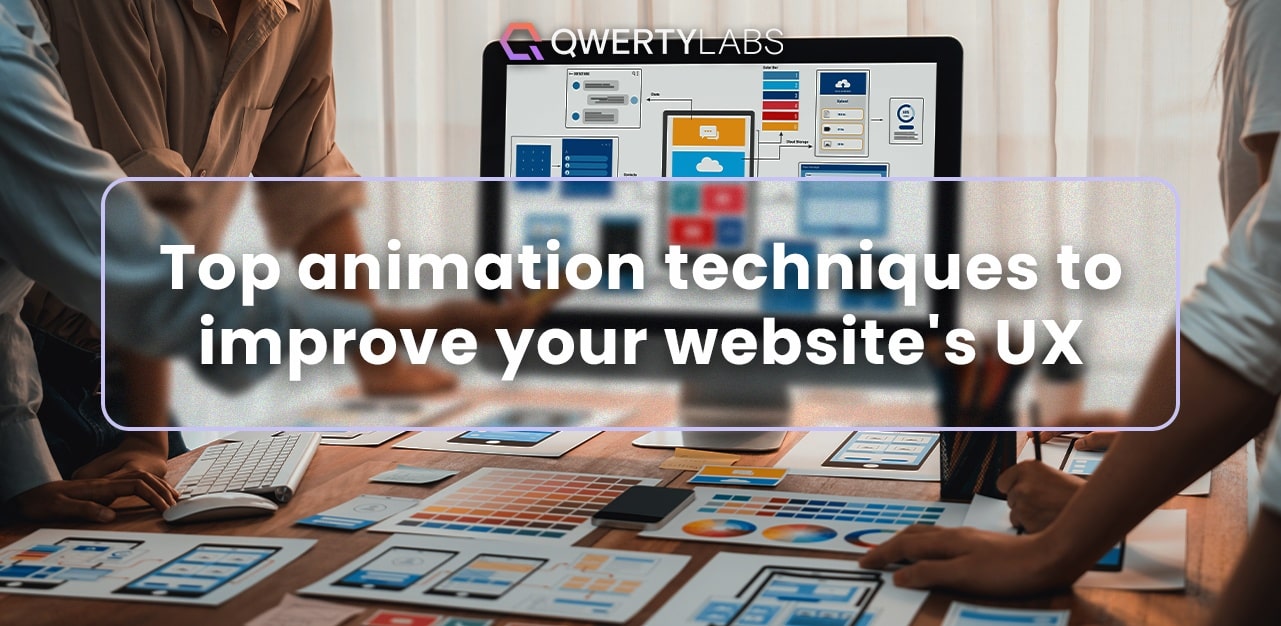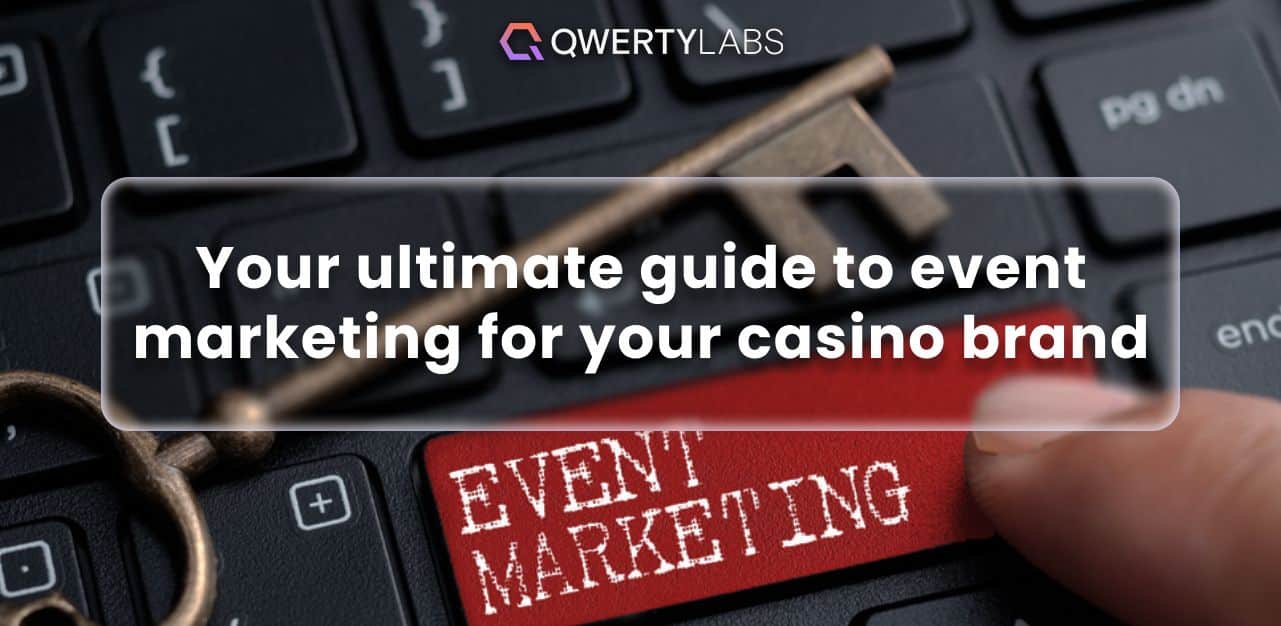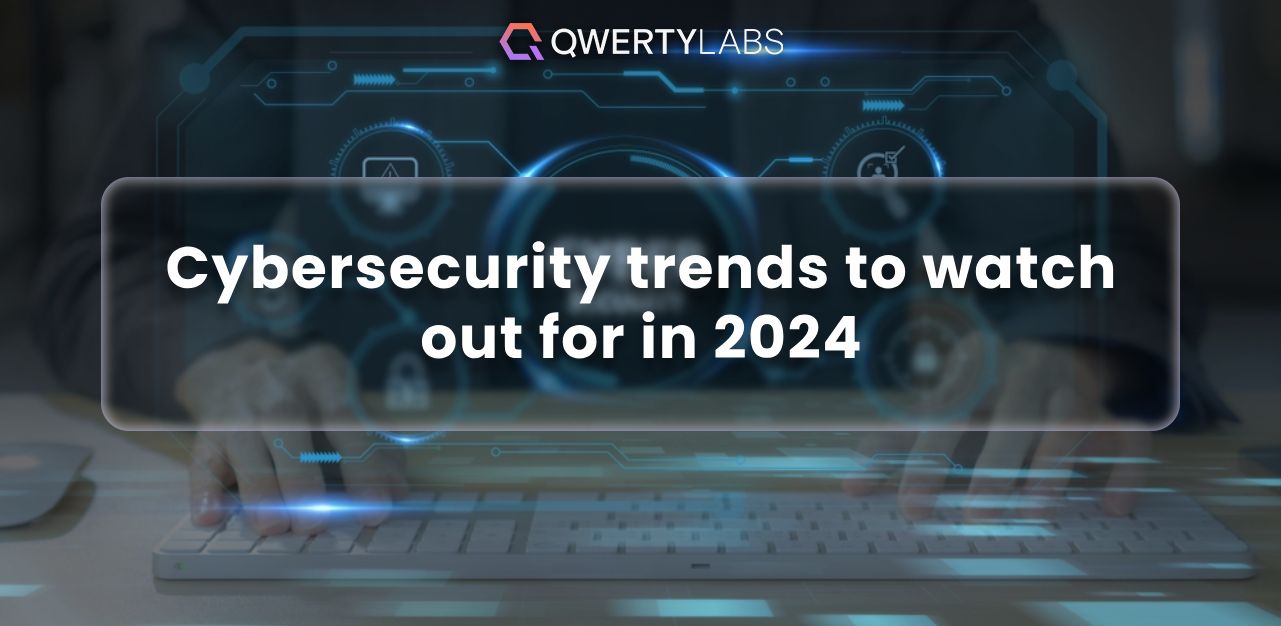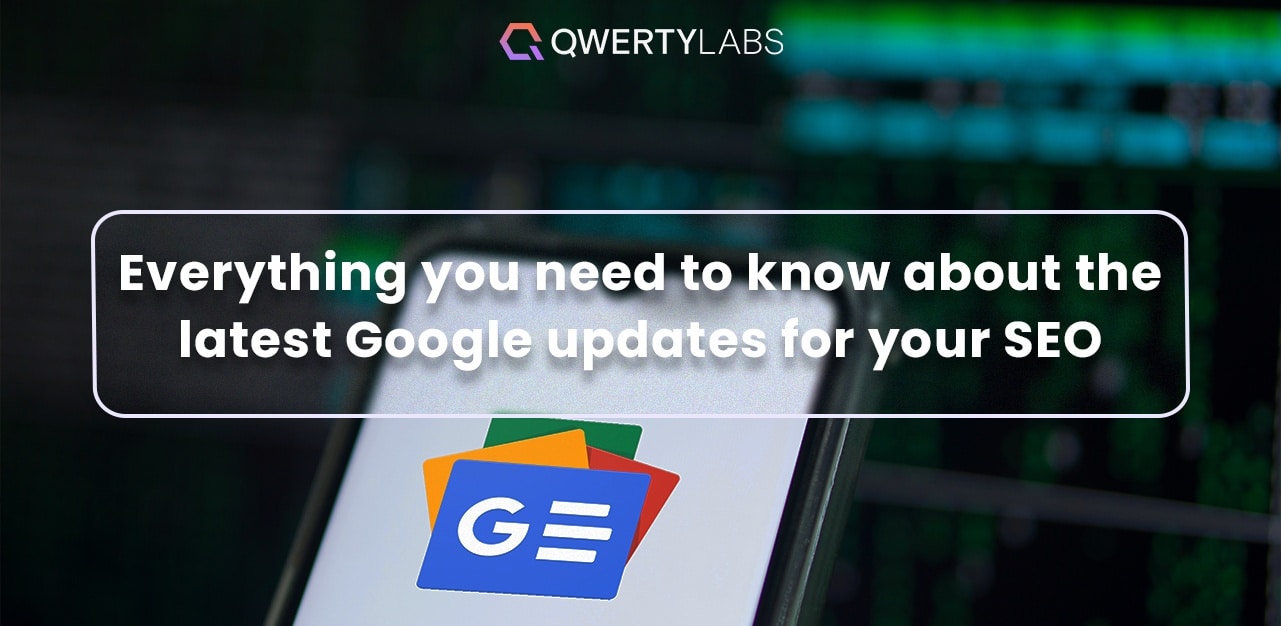Engage your audience with the right brand event marketing strategy. Discover tips and tricks to create impactful events with QWERTYLABS.

Web design animations offer more than just eye candy while browsing a site. They highlight interactive features and guide readers around the platform, enhancing their website user experience. These are just a few ways animation can benefit your website and brand.
Find out how this seemingly small part of your website can impact your user’s experience and increase your site’s engagement in this QWERTYLABS blog.
Using animated pictures on a web page to enhance user experience is known as website animation. It uses CSS, JavaScript, and HTML5 technologies to generate visually appealing effects, transitions, and animated components on a website.
These animations can include everything from subtle hover effects to large interactive content. In on-page SEO, website UX animation is beneficial because it captures users' attention, guides them to the next page, or indicates a site’s loading element. Overall, this makes the user interface more engaging and memorable.

User Experience (UX) animation is the strategic use of motion and transitions in digital interfaces to enhance the overall user experience. It goes beyond aesthetics, aiming to engage readers, guide user attention, and ensure seamless website exploration.
By adding subtle animations, such as micro-interactions or transitions, designers can make the user interface more intuitive and enjoyable. As a result, this captures user attention and encourages exploration, as animations can highlight interactive elements, convey changes in state, or provide feedback.
In essence, UX animation is a powerful tool to elevate user engagement, contributing to a more compelling and user-friendly digital experience.

Animation on a website does more than just provide visual appeal. Instead, it can be a significant component that improves the whole interface and user experience.
Learn more about the importance of animation and the most common techniques for website UX in this section.
The ‘focus’ aspect purposefully guides readers and directs their attention towards specific components of a user's online experience, such as articles, partner links, or photo galleries. What a reader sees on a page, how it's presented, and why it's emphasised all contribute to directing the user's attention.
Achieving this goal promotes user engagement and ensures that critical content is seen. A website's design selections, such as visual hierarchy and appealing call-to-action components, can successfully guide a user's attention. This improves the entire experience and increases the potential for meaningful engagement with crucial elements.
Regarding big websites, hints are handy as they serve as subtle indicators that guide readers to essential elements, such as accessibility or usability options. For example, hinting about the presence of a dark mode encourages users to investigate and activate it for easier viewing.
This feature can then cater to a wide range of users who prefer reading with less light. This shows that a brand will consider the reader’s comfort and inclusion, resulting in a more personalised and pleasurable browsing experience.
The 'notify' technique tells users about completed actions or tasks on the site as part of a user's online experience. Notifications give real-time updates, whether for a downloaded item or a successful document submission.
There are various notification animation formats, like simple page pop-ups that indicate an update. The notify animation technique is used mainly to keep users informed and engaged by providing a seamless and responsive interaction. An exemplary implementation of this technique leads to enhanced user satisfaction by quickly acknowledging the completion of their actions.
Having animations integrated within your website allows you to include your brand's unique personality and charm. What you animate, how you incorporate logos, and your unique animation methods all contribute to your brand's identity.
We can consider big brand examples like Disney, whose charming characters are animated and used to entertain site users while waiting for a page to load. Because of this, the brand benefits from the fun and attention that characters get while not boring readers.
Giving users the necessary navigation and notification indicators is called ‘orientation’. This helps users navigate the site and see which part of the page or website they’re on. For example, orientation animations in a blog post help readers identify subtopics and their progression throughout the article.
Giving users the necessary orientation can range from simple blue dot indicators on the site to a complex and responsive tracker showing you the table of contents and your progression while you read.
Now, let’s look at some variations of animation techniques you’ll find on a website. Some of these animation styles can be found at a glance, while others may be more subtle in application, so look out for any you can find while scrolling to see how they’re applied.
Micro-interactions refer to simple and quick animations or replies to user activities on a website or app. These little, subtle animations are triggered by clicks or hovers, providing users with rapid feedback and improving the overall user experience. The overall goal of this technique is to make interactions more natural, engaging, and responsive. This should result in a smoother and more visually appealing interface that directs users and adds a layer of complexity to the design.
Parallax scrolling is a method in which background pictures move faster than foreground content when the viewer scrolls down a website, providing the appearance of depth and immersion.
This website animation effect is created by programming backdrop layers to move at different rates. The goal is to provide consumers a dynamic and engaging experience as they travel through the material by adding visual interest, depth, and storytelling to the homepage.
Responsive animation adapts its behaviour depending on the device or screen size of the user, delivering a consistent experience across all platforms. It optimises speed by tailoring animations to different screen sizes using CSS media queries or JavaScript.
Its goal is to keep visual appeal and functionality consistent across devices. To guarantee a consistent and user-friendly display, a website may scale and reposition animated components differently on a desktop vs a mobile device.
Sticky elements are web components that stay in place while users scroll. They are achieved using CSS or JavaScript and remain visible, enabling ongoing access to critical elements like navigation menus.
The primary goal is to improve user experience by keeping important parts readily available, creating a fluid and accessible navigation experience while users explore the material without losing access to critical capabilities.
Popular examples of this include newsletter sign-up pages or promotional sticky elements that redirect you to a page with more details on the event.
Hover animations are a type of animation technique that involves visual changes to web page elements when a user hovers their cursor over them. These animations, created using CSS or JavaScript, provide immediate feedback, indicating interactivity. They enhance user engagement and guide navigation by signalling clickable areas. For example, a button changing colour or an image enlarging upon hover adds a dynamic element and communicates to users that these elements are interactive.

Developers build seamless web animation elements with specific tools and technology. Learn what they are below:
CSS (Cascading Style Sheets) is a style sheet language used in web development to customise HTML and XML data display. CSS uses features like '@keyframes' to build animation sequences for web animations, allowing developers to control the appearance and behaviour of objects on a webpage.
CSS animations became known for web development in the early 2010s as browsers embraced more current CSS3 capabilities.
JavaScript is a powerful programming language widely used in web development and manipulates HTML and CSS in real time for web animations. Because of how it works and frameworks like GSAP, responding to user inputs or initiating animations is a cinch.
JavaScript, first offered in web browsers in 1995, quickly became an essential tool for early developers as it helped create interactive web content. This transformed simple web pages into engaging and dynamic sites, generating positive buzz and quick reception.
SVG, or Scalable Vector Graphics, is an XML-based format for describing vector graphics. In web animations, SVG allows for creating scalable and resolution-independent graphics and defining shapes, text, and paths, making it popular for dynamic web design practises.
Popular features for SVG include applying animations, transformations, and interactivity directly within the XML markup. This allows developers to make diverse and highly responsive animations and visuals for websites without relying on static image formats.
Python is a robust and adaptable programming language known for its server-side programming features and simplicity. It can also be used for web animations, especially with libraries like Pygame or frameworks like Flask, making it incredibly versatile.
Python's significant traits include straightforward syntax, huge libraries, and frameworks that ease the web development process. As a result, this makes it a popular and accessible choice for developers looking for efficiency and flexibility when creating animated online content.
Rust, while less widely used than JavaScript, may be converted to WebAssembly for fast web animations. It’s also known for its safety and performance, which can range from simple to complex, allowing for flexibility.
Mozilla, the creator of Rust, intended to provide the platform with more memory safety without losing efficiency. With this as its foundation, Rust and WebAssembly now provide a high-performance option for building complicated and resource-intensive online animations.

The benefits of creating website animations include everything from utilising animation as a visual aid to lengthening user retention within a site and boosting brand performance.
Good website animations help users in making better judgements by simplifying complex information. Customers can grasp graphically explained information through animated product demos or interactive infographics. This visual tool aids decision-making by allowing a clearer and more entertaining examination of items or services. Good-quality animations simplify decision-making, ensuring that customers are well-informed and confident.
Users captivated by website animations will stay longer and are more willing to explore other website elements, improving their entire experience. These animations make a site visually engaging and exciting, reducing user boredom.
Engaged visitors are more inclined to explore information and spend more time on the site. This increases customer happiness and has a favourable influence on measures such as bounce rates, resulting in a more successful online presence.
Incorporating website animations helps users navigate websites by providing visual cues. Animated components, including menus and scrolling effects, aid in directing attention and ensuring a seamless flow around the site.
These animations give visitors a more straightforward and entertaining browsing experience, making exploring different parts easier. Users can quickly locate what they're searching for by boosting navigation using animations, improving overall satisfaction and engagement.
Website animations are effective visual tools that help users understand the material on the website effectively. Animations are used in design and coding to present information visually appealingly. They help people through reading, highlighting crucial material, and simplifying complex concepts. This improves user comprehension and offers a more fun and efficient surfing experience, encouraging good communication.
Brand recognition is a significant benefit a company can get by simply incorporating unique animations. Different and consistent animations generate a distinctive visual identity that reinforces the brand's personality and values. When consumers come across visually appealing and distinct animations, it helps to strengthen the bond between the audience and the brand.
This recognition can build trust, boost brand memory, and separate the website from competitors, resulting in a more pleasant and long-lasting engagement with visitors.

To optimise user experience, it's crucial to implement website animations while knowing the best practices for each. These best practices ensure you don’t waste valuable resources like time and effort into making animations that don’t improve your site or the user’s time on the website. Learn more about it when you read ahead.
Purposeful website animations in UX design improve the user experience by successfully expressing information. Using animations strategically, such as guiding users through navigation or emphasising essential areas, reduces visual clutter and confusion.
This deliberate approach guarantees a smooth and interesting interaction, contributing to a user-friendly interface. Best practices mandate that each animation serve a specific purpose, balancing design and utility for maximum use.
Website animation performance optimisation is critical for a smooth user experience. Animations load faster and take less time to load when files are compressed, and code is optimised.
This increases the user’s experience, especially on mobile devices and for areas with slower connections. Prioritising performance ensures that interactions go smoothly, with no lag or interruptions.
Consistency and cohesion are other elements that designers and animators must consider to maintain a uniform style and timing across animations. This standardisation allows users to browse more consistently, reducing confusion and improving overall usability.
Consistency in design components and animation patterns strengthens brand identification, generating a unified and memorable online presence that people respond to.
These tips and tricks for animations can improve your user experience, but implementing them can be difficult. That’s where QWERTYLABS can help you!
Effective website animation has a lot of benefits, like boosting visual appeal and engaging users with interactive animated interfaces. Popular coding languages like JavaScript and HTML/CSS are needed to pull these animations off and make them versatile and adaptable.
Prioritising website animations enhances aesthetics and ensures users a smooth online experience. To ensure your website is optimised for excellent user experience through animations, contact QWERTYLABS! Our team of webmasters can help your platform become more efficient in bringing in those impressions and clicks your brand is after.
We can also help you improve your site by adding smart content that will keep your target audience hooked and engaged. We offer only some services besides brand protection, link building and more. Learn more about what our team at QWERTYLABS can do for you when you inquire about us here.
Simple and subtle animation techniques, such as fade-ins, transitions, and micro-interactions, are recommended to improve a user’s website experience.
Some of the significant benefits of web animation include enhancing user engagement, improving navigation, and making content more accessible to digest.
The best practices for implementing animation on a website include ensuring purposeful animations, optimising performance, and maintaining consistency in design and timing.
Animations for websites can be made using coding languages like JavaScript or through animation tools and software like Adobe Animate or After Effects.
Web animation techniques like parallax scrolling, responsive animation, and sticky elements help improve a user’s experience by highlighting other features or making the browsing experience smoother.

 A guide to proper brand event marketing to elevate your business
A guide to proper brand event marketing to elevate your business
Engage your audience with the right brand event marketing strategy. Discover tips and tricks to create impactful events with QWERTYLABS.
 Cybersecurity trends 2024: What online casinos should know
Cybersecurity trends 2024: What online casinos should know
Stay on top of your site's cyber security by learning trends like Zero Trust Security and Supply Chain Attacks. Learn more about it at QWERTYLABS.
 The latest Google search algorithm updates for SEO success
The latest Google search algorithm updates for SEO success
In 2024, Google remains the top choice for finding answers online. That’s why it continuously refines its search policies and algorithms to improve user experience (UX) and provide more accurate search results.
8F, One Trium Tower,
Filinvest Avenue, Alabang, Muntinlupa, Metro Manila
Philippines, 1799
[email protected]
+63 (02) 8971 8926